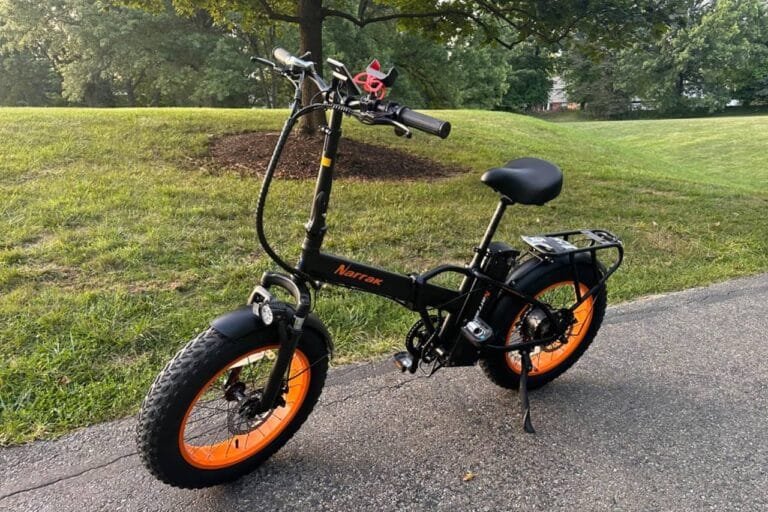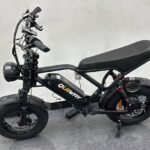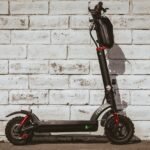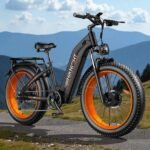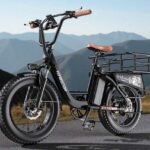![Best Electric Bikes for Hills Under $1,000 ([year]): Real Climbers, Real Value 5 Best E-Bikes for Steep Hills Under $1,000: Tested Picks You Can Buy](https://goebikelife.com/wp-content/uploads/2025/09/Best-Electric-Bikes-for-Hills-Under-1000.jpg)
If your rides regularly include punchy climbs or long, grinding grades, choosing the right e-bike under $1,000 can mean the difference between cruising to the top and walking the last hundred yards. This guide distills what actually matters for hills—torque, voltage/current, gearing, wheel/tire choice, and weight—then ranks five popular models you asked about in the order I’d buy them for hilly terrain.
I’ve kept it practical, decisive, and focused on real-world climbing, not just brochure numbers. Specs are cited where relevant; everything else is straight talk based on how these configurations typically behave on hills.
Quick Picks (Ranked)
1. Movcan V60 — Best Overall Hill Climber Under $1,000
A 48V system with a strong 1000W motor, compact 20×4.0″ tires for leverage, full suspension for traction, and frequent sale pricing well under $1,000. Great mix of grunt, gearing, and control for steep neighborhoods and park paths.
2. Cybervelo EK2 — Best Budget All-Rounder for Rolling Hills
26″ wheels, 7-speed, front + saddle suspension, mechanical discs w/ EABS, and a “peak 1000W” setup that’s noticeably stronger than the 350–500W budget crowd. Ideal for moderate hills and longer commutes when you pedal along.
3. KAIJIELAISI V3 — AWD Hill Crusher (Stretch Pick; Watch for Sub-$1,000 Deals)
Dual motors (claimed 2000W continuous, 4000W peak), 48V 23Ah battery, hydraulic brakes, and 85 Nm torque with a switch for single/dual motor. Stellar for truly steep climbs; price often sits above $1,000, so it’s a sale-watch pick for this budget.
4. HiKNiGHT H6 Pro — Full-Suspension Dual-Motor Bruiser (Stretch Pick)
52V 20Ah battery and dual 1000W motors (3,000W peak) with a strong torque claim and 35° slope marketing. More capable than most single-motor bikes on brutal hills, but usually priced beyond this guide’s ceiling unless discounted.
5. GREATWORK M8 — Most Power on the List (Stretch/Over-Budget Pick)
Dual motors (listed 5000W peak) on a 52V system, large battery, 26×4.0″ tires, hydraulic stopping—about as “point-and-go uphill” as it gets for a hub-drive, but typically above $1,000. Include only if your budget is flexible.
Why this order? I weighted actual hill utility under a $1,000 cap. Dual-motor fat bikes (V3, H6 Pro, M8) dominate raw hill punch, but they frequently exceed the budget. The Movcan V60 offers the strongest consistent hill performance at or below $1,000, with the Cybervelo EK2 a value alternative for riders who face moderate grades and prioritize comfort/range.
What Makes an E-Bike Good on Hills?
1) Torque and Current Delivery (not just “watts”)
Peak watt numbers are marketing shorthand. What matters for climbing is how much torque and controller current your system can deliver at low speed. Higher system voltage (48V or 52V) and a generous controller current translate to better push on steep grades.
2) Single vs Dual Motor
Dual-motor AWD bikes can “tractor” up climbs and keep traction on loose surfaces. The trade-offs: higher weight, higher price, and more battery drain. If your budget is strict at $1,000, you’ll usually find better value in a strong single-motor 48V bike.
3) Gearing & Wheel Size
A 7-speed (or more) cassette lets you keep cadence in the power band. Smaller wheels (20″ fat) give mechanical advantage at the hub and can feel more eager uphill. Larger wheels (26″) roll smoother and hold speed once you’re moving but ask a bit more from the motor on the steepest ramps.
4) Tires & Traction
Wider tires (3.0–4.0″) increase contact patch and grip, which matters when you’re crawling up steep, dusty, or wet pitches. The flip side is more rolling resistance on flats.
5) Weight & Rider Input
No surprise: lighter bikes climb easier. Regardless of motor size, pedaling with a sensible cadence (70–90 rpm) in a low gear helps the controller and motor stay cool and efficient on long climbs.
Our Top 5 Picks—Deep Dive Reviews
1) Movcan V60 — Best Overall Hill Climber Under $1,000
Why it wins for hills at this price:
The V60 packs a 1000W hub motor on a 48V system with a 15.6Ah battery and a 30 mph claim, but the real hill advantage is the 20×4.0″ tire + full-suspension combo. The smaller wheel diameter gives the motor leverage at low speed, helping you maintain momentum without bogging down, while the suspension keeps the rear tire hooked up on rough climbs. Movcan markets 30° hill capability; take that with a grain of salt, but the underlying configuration is exactly what you want for steep neighborhoods. On the brand site, V60 frequently sells well under $1,000 depending on promo.
Key specs (claimed):
- Motor & System: 1000W hub (48V), with a 30 mph top-speed claim.
- Battery: 48V 15.6Ah removable (about 748 Wh).
- Wheels/Tires: 20×4.0″ fat tires for traction and leverage.
- Suspension: Full suspension (helps traction on chattery climbs).
- Range: up to ~70 miles (PAS) under ideal conditions per brand page.
Hill performance:
Start climbs in a low gear with PAS 3–5, keep cadence up, and it will dispatch 8–12% grades without drama. On longer, 10–15% sustained hills, plan to pedal along to keep controller temps reasonable. The short wheelbase and smaller tires let it “pop” over rises that make 26” commuters feel sluggish.
Pros
- Compact wheel leverage + full-suspension traction = confident climbing feel
- Frequently priced well below $1,000 on the brand site (watch coupons)
- 20×4.0″ tires hook up on dirt/loose pavement
Cons
- Smaller wheels spin faster on flats; you’ll notice more revvy feel at 25–30 mph
- Fat tires add rolling resistance; range claims assume conservative PAS
Verdict:
For riders who routinely meet double-digit grades and want maximum hill competence without breaking $1,000, the V60 is the most complete package here.
2) Cybervelo EK2 — Best Budget All-Rounder for Rolling Hills
Why it’s here:
If your hills are real but not San-Francisco-level, the EK2 delivers a strong “peak 1000W” punch, 26″ wheels for calmer handling at speed, and reassuring features—front + saddle suspension and mechanical discs with EABS—at a price that usually fits easily under $1,000 on Amazon (watch coupons). The listing claims 25+ mph and “up to 80+ miles” range under ideal conditions.
Key specs (claimed):
- Motor & Speed: Peak 1000W, 25+ mph claim.
- Battery/Range: Marketing cites “up to 80+ miles” (PAS); expect a mid-size 48V pack.
- Brakes: Front/rear mechanical discs + EABS.
- Suspension: Adjustable front fork + saddle shock.
- Drivetrain: 7-speed; LCD with PAS modes and cruise control.
Hill performance:
On typical residential 6–10% climbs, PAS 3–5 + a low gear returns steady progress without overheating in normal temps. On very steep, long grades, you’ll work with it—keep cadence up and don’t be afraid to gear down early. The 26″ wheels are smoother over gaps than 20″, but they put slightly more load on the motor at the same slope; plan to pedal.
Pros
- Solid hill pep compared to 350–500W commuter e-bikes
- Comfort + stability at speed thanks to 26″ wheels and dual shock points
- Usually a friendly price and frequent coupons on Amazon
Cons
- Mechanical (not hydraulic) discs; adjust cables regularly
- Marketing ranges are optimistic unless you stay in lower PAS
- Not an “AWD tractor”—for truly brutal gradients, see the dual-motor picks
Verdict:
A sensible, inexpensive hill-friendly commuter that does the job on rolling terrain and moderate climbs—ideal if you want comfort and range without chasing gnarly grades.
3) KAIJIELAISI V3 — AWD Hill Crusher (Stretch Pick)
Why it’s compelling:
When it comes to steep hills, AWD hub-drives are hard to beat for sheer “point and go” traction and thrust. The V3 lists dual motors (2000W cont., 4000W peak), 85 Nm torque, a 48V 23Ah (1104 Wh) battery, dual hydraulic brakes, and a 34 mph claim with a menu to unlock the limiter. It’s a climb-anything configuration—if you catch it under $1,000.
Key specs (claimed):
- Drivetrain: Dual motors; switchable single/dual-motor modes
- Battery: 48V 23Ah (~1104 Wh) removable pack
- Brakes/Suspension: Dual hydraulic discs; suspension fork
- Top Speed: Up to 34 mph (unlocked)
- Claimed Climb: 40° (marketing) with 85 Nm torque
Hill performance:
On the steep stuff, the V3 feels like a small bulldozer. The front hub helps keep the bike moving when the rear starts to lighten on very steep grades. Just remember that AWD + fat tires + higher speed = heavier draw. Long alpine climbs will chew through charge faster than on a single-motor commuter.
Pros
- Grips and goes where single-motor 26″ commuters can stall
- Hydraulic brakes are the right call for heavy hill work
- Big battery helps offset the AWD appetite
Cons
- Weight and price usually above $1,000
- More parts to maintain; mind brake set-up and spoke tension
- On pavement, AWD can feel overkill unless you truly need it
Verdict:
The performance is absolutely there for steep terrain. If your budget can stretch or you spot a rare sub-$1,000 deal, this is a legit hill monster.
4) HiKNiGHT H6 Pro — Full-Suspension Dual-Motor Bruiser (Stretch)
Why it’s here:
HiKNiGHT’s H6 Pro advertises dual 1000W motors (3000W peak), a 52V 20Ah battery, full suspension, and dual hydraulic brakes, with claims of 140 Nm torque, 38 mph top speed, and 35° hill capability. That is a high-powered, sure-footed combo for aggressive climbing and rough terrain, though it tends to live above the $1,000 line.
Key specs (claimed):
- System: 52V 20Ah battery; dual 1000W motors, 3000W peak
- Top Speed & Slope: 38 mph and 35° climb claims; 140 Nm torque stated in listing text
- Chassis/Brakes: Full suspension; dual hydraulic discs
Hill performance:
Compared to single-motor 48V commuters, the H6 Pro feels relaxed on long, steep ramps—less surge, more steady pull. On loose or rutted climbs, the suspension works with the fat tires to maintain contact and traction. You’ll pay the price in watts: budget extra battery for repeated climbs.
Pros
- 52V headroom, hydraulic brakes, full-suspension control
- AWD confidence on loose or off-camber steeps
Cons
- Generally not under $1,000 unless heavily discounted
- Heavier platform; mind lift/transport
- Range on high PAS/dual-motor will drop on sustained climbs
Verdict:
If you regularly ride very steep, rough hills and can push past $1,000, H6 Pro is built for it.
5) GREATWORK M8 — Most Power on the List (Stretch/Over-Budget)
Why include it?
Because it sets the ceiling for hill authority in this group: dual motors (listed 5000W peak), 52V 25Ah battery (~1300 Wh), 26×4.0″ fat tires, dual suspension, and hydraulic brakes. Claimed 45 mph top speed and “up to 100 miles” PAS range. The catch: typical pricing exceeds $1,000; still, it’s useful context for what “max hill” looks like in this family.
Key specs (claimed):
- Motors: Two 2000W (peak 2500W each), 5000W peak total; claim of 180 Nm torque and 40° climbs
- Battery: 52V 25Ah (~1300 Wh); PAS range up to 100 miles (idealized)
- Top Speed: 45 mph claim; hydraulic brakes and dual suspension
Hill performance:
On short, very steep ramps, M8 behaves like a winch—stand over the front, keep cadence, and it’ll walk up lines that stall lighter commuters. For repeated long climbs, budget ample charge; pushing big motors uphill is energy-intensive.
Pros
- The most “effortless” climber here in raw thrust
- Big battery and hydraulics fit the power profile
Cons
- Usually well above $1,000
- Heavy; not a stair-friendly or car-rack-friendly choice
- Overkill if your hills are modest
Verdict:
A useful reference point for ultimate hill punch. If you must stay under $1,000, treat it as a benchmark rather than a buy.
Side-by-Side Comparison (Key Hill Factors)
| Model | System / Battery | Motor(s) | Tires | Brakes | Suspension | Claimed Top Speed | Claimed Range | Notable Hill Claim |
|---|---|---|---|---|---|---|---|---|
| Movcan V60 | 48V, 15.6Ah | Single 1000W | 20×4.0″ | (varies by trim; typically disc) | Full | 30 mph | ~70 miles PAS | 30° (marketing) |
| Cybervelo EK2 | 48V (capacity varies) | Peak 1000W | 26×(2.1–2.3″) | Mechanical + EABS | Fork + saddle | 25+ mph | “Up to 80+ miles” | — |
| KAIJIELAISI V3 | 48V 23Ah | Dual (2000W cont., 4000W peak) | 26×4.0″ | Hydraulic | Fork | 34 mph (unlockable) | 30+–50+ (listing) | 40°, 85 Nm |
| HiKNiGHT H6 Pro | 52V 20Ah | Dual (3000W peak) | 26×4.0″ | Hydraulic | Full | 38 mph | up to 90 miles (listing) | 35°, 140 Nm |
| GREATWORK M8 | 52V 25Ah | Dual (5000W peak) | 26×4.0″ | Hydraulic | Dual | 45 mph | up to 100 miles PAS | 40° (marketing) |
How to Choose for Your Hills (Fast Checklist)
- Grades up to ~10% (short): A strong single-motor 48V bike with decent gearing is fine (Movcan V60, Cybervelo EK2).
- Regular double-digit grades or loose surfaces: Consider fat tires and suspension for traction.
- Long steep climbs or frequent gravel climbs: If budget allows, AWD/dual-motor with hydraulic brakes (V3/H6 Pro) makes life easier—just plan your battery use.
- Heavier riders / cargo: Prioritize 52V or higher current controllers, strong wheel builds, and brakes.
- Range on hills: Expect 20–40% less than marketing ranges if you spend a lot of time climbing at higher PAS.
- Brakes: Hydraulic discs are strongly preferred for frequent, steep downhills.
Hill-Riding Setup Tips (Make Any E-Bike Climb Better)
- Start in a low gear and shift early as the hill begins. Let cadence stay 70–90 rpm.
- Use higher PAS only as needed; living in PAS 5 the whole hill can overheat systems on hot days.
- Keep weight forward on very steep grades to keep the front tire planted; seated climbing improves traction.
- Check tire pressure: aim for the low-to-mid range of the tire’s rating on rough climbs to increase grip (don’t go so low you risk pinch flats).
- Cool-down coasts between repeated climbs; heat is the enemy of controllers and hub motors.
- Service brakes and cables (or fluid) regularly; hills expose weak braking setups quickly.
- Don’t chase top speed uphill—smooth power wins. If you’re bogging at low cadence in too high a gear, downshift.
Frequently Asked Questions (Hills + Budget E-Bikes)
How many watts do I need for hills under $1,000?
For riders around 150–200 lb on typical urban hills (6–12%), a well-tuned 48V single-motor bike with a robust controller (often marketed as 750–1000W) plus sensible gearing is enough—if you pedal. For heavier riders, cargo, or steeper/looser climbs, AWD/dual-motor helps—but often costs more than $1,000.
Is AWD worth it?
For truly steep or loose climbs, yes—the ability to pull from the front keeps traction when the rear unweights. The trade-offs are price, weight, and consumption. If your cap is firm at $1,000, a sturdy single-motor with smaller wheels (like V60) is often the smarter buy.
20″ fat vs 26″ tire for hills?
20″ fat = more leverage at the hub and easy slow-speed tractoring; 26″ = smoother, stable at speed, and better rollover. For hill climbing feel at this budget, 20×4.0″ is a secret weapon.
Hydraulic vs mechanical brakes?
If you ride steep terrain often, hydraulic is worth it—better modulation and less hand fatigue. Mechanical discs can work (Cybervelo EK2) but need regular attention to keep performance sharp.
Will these bikes really hit the stated “mph” and “miles”?
Treat top speed and range as best-case numbers. Expect lower real-world speeds on steep climbs and 20–40% less range in hilly cities, especially at higher PAS.
Clear Recommendations (No Fence-Sitting)
- You want the best climber under $1,000 today: Movcan V60 — the configuration (1000W/48V, 20×4.0″, full-suspension) just works on steep ground, and the pricing tends to cooperate.
- Your hills are moderate and you prefer 26″ comfort: Cybervelo EK2 — strong value, comfortable ride, good enough grunt if you pedal sensibly.
- Your hills are nasty and you can stretch above $1,000: KAIJIELAISI V3 (easiest upgrade path), or HiKNiGHT H6 Pro if you also want full-suspension control.
- You want the most hill authority on this list and price is secondary: GREATWORK M8. It’s the hammer, with the weight and price to match.
Buyer’s Notes on Price, Safety & Warranty
- Pricing: Amazon and brand sites move quickly—watch coupons and lightning deals. The Movcan V60 often dips well below $1,000 on the brand site. Dual-motor bikes (V3/H6 Pro/M8) typically exceed $1,000 but can briefly flirt with our cap; confirm live price before you buy.
- UL/Compliance: Some listings highlight UL 2849 battery/system language. If certification matters to you, look for that in the product page or manual.
- Brakes & Tires: If you ride long, steep downhills, prioritize hydraulic brakes and keep fat-tire pressures sensible for grip and heat control.
Final Word
If I were buying today with hills in mind and a hard $1,000 cap, I’d pick the Movcan V60 for its blend of steep-grade composure, traction, and pricing consistency, and I’d keep the Cybervelo EK2 as my value/comfort alternative for moderate hills. If you later find yourself craving “tractor mode,” keep an eye on sales for the KAIJIELAISI V3—that’s the cleanest step up to AWD hill power.


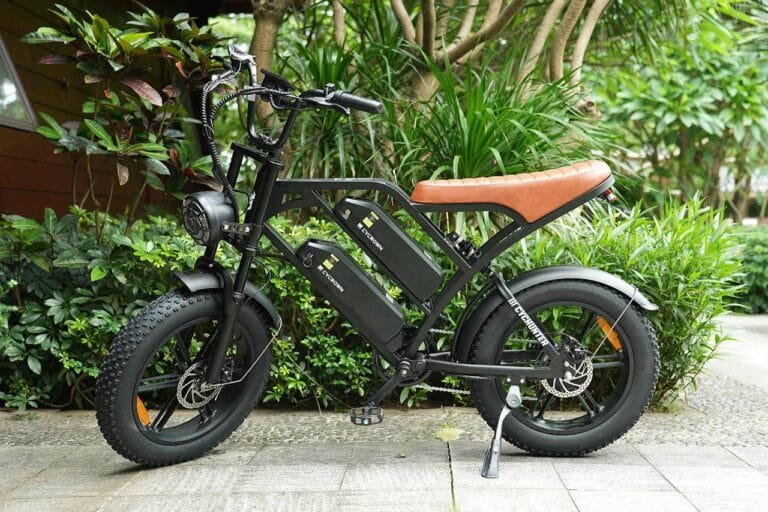
![Power and Range for Your Ride: The [year] Hiboy EX6 Electric Bike Review Hiboy EX6 Electric Bike Review](https://goebikelife.com/wp-content/uploads/2024/12/Hiboy-EX6-E-Bike-Review-768x512.jpg)
